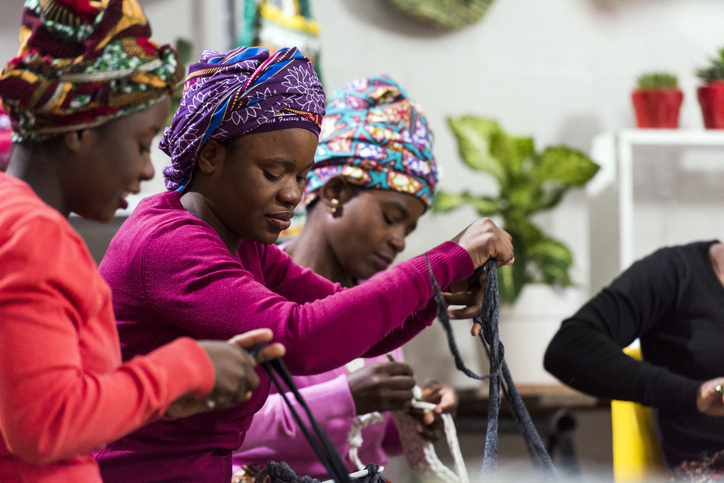How do poverty rates differ by gender and age within families? This column reports research that uses new analytical techniques and data from a range of low, lower-middle, and upper-middle income countries – Albania, Bangladesh, Bulgaria, and Malawi – to measure intra-household inequality in resource allocation and poverty. The evidence indicates that in all four countries, the standard approach of using household consumption per capita as a proxy for individual consumption underestimates poverty rates, particularly among women and children.
Why are many men, women, and children are poor? This seemingly straightforward question has assumed even greater urgency over the past couple of months, given the mounting evidence that while men have been more likely than women to lose their lives from Covid-19, women lost out more than men in terms of jobs, income, and safety.
Unfortunately, answering this question is anything but straightforward. Our new study makes important theoretical and empirical contributions to the body of work on how to measure differences in resource allocation within households and individual-level poverty.
Having greater understanding of differences in poverty within households could have a significant positive impact on policy. For example, it could be decisive in targeting social protection programs more effectively. If some groups of individuals – such as women, children, the elderly, foster children, or co-wives in polygamous marriages – are poorer than other individuals living in the same households, existing household-level targeting approaches could easily miss a large share of the poor population.
Similarly, if malnutrition is mostly or partly due to unequal resource allocation within households, existing approaches to improving nutrition outcomes by increasing food supply and access may fall short. In that case, they would need to be augmented with interventions that directly target the norms or customs that determine intra-household inequality – the Rajasthan Nutrition Project is an example of such an approach.
Monetary poverty measures are typically based on consumption, and household surveys usually collect consumption data for the household as a whole, rather than for individual household members. As a result, individuals are typically classified as poor or non-poor in accordance with the poverty status of the households in which they live – that is, based on household consumption per capita. This is a problem if there is inequality in consumption across people within households.
But measuring differences in consumption between men, women, and children living in the same household is not an easy task. This is partly tied to how household surveys collect consumption data. We do not have cost-effective methods to elicit who in the household consumed how much of each consumption good, especially in view of shared meals and foodstuffs.
For example, think about a bottle of milk. While it is straightforward to collect information on the household’s expenditure on milk, it is generally not feasible to measure each individual’s milk consumption through either interviewer observation or each household member measuring and recording his or her milk consumption.
In addition, expenditure may not equal consumption. For example, if shelter is completely shareable, then two people can each spend $500 on shelter, but may each experience a consumption flow of $1,000. But when it comes to measuring material deprivation, we are interested specifically in consumption. The difficulty and cost of assigning expenditures to individual people, and the distinction between expenditures and consumption, make it hard to observe directly (or measure through household surveys) the total consumption flow to each individual within a household.
As a result, researchers have long sought to estimate intra-household resource allocation by developing structural models of household decision-making, and making the most of available survey data in which parts of household expenditure can be ‘assigned’ to individual household members or age-and gender-disaggregated groups of household members.
An important contribution to this body of research is the workhorse model developed by Geoffrey Dunbar, Arthur Lewbel, and Krishna Pendakur. On the basis of this model, Rossella Calvi shows that intra-household inequality in resource allocation can explain mortality rates of older women in India, while Jacob Penglase leverages it to explore inequality between foster and non-foster children in Malawi.
Since this model remains computationally complex, Valerie Lechene, Krishna Pendakur and Alexander Wolf propose a linear version of the model, which can be estimated with off-the-shelf household survey data. All that is needed, beyond standard household consumption data, is one item that is known (by the researcher) to be consumed only by one individual – or one group of individuals – in the household (for example, clothing expenditures, separately for men, women, and children).
In our new study, we use this model to examine a question that would otherwise be unanswerable, which is how poverty rates differ by gender and age, using data from a range of low-, lower-middle, and upper-middle income countries, namely Albania, Bangladesh, Bulgaria, and Malawi.
Figure 1:
Poverty rates of women and men in Albania, Bangladesh, Bulgaria, Iraq, and Malawi

Note: The vertical axis shows the headcount poverty rate of men and women, both the point estimate and the confidence interval, under the assumption of unequal sharing. The results are based on the Albania Living Standards Measurement Survey 2008, Bangladesh Integrated Household Survey 2015, Bulgaria Multitopic Household Survey 2003 and Malawi Third Integrated Household Survey 2010/11. In all countries, the privately assignable good is clothing, except for Bangladesh where we derive estimates based on two different privately assignable goods: clothing versus food. The poverty lines are as follows: $1.90 per person per day for Malawi (a low-income country), $3.20 for Bangladesh (a lower middle-income country) and $5.50 for Albania and Bulgaria (upper middle-income countries). Poverty estimates are based on the modified OECD equivalence scale and per capita poverty lines are rescaled by the ratio of the number of household members to the number of adult equivalents among households close to the poverty line (as proposed by Martin Ravallion in the context of testing the scale sensitivity of poverty measures).
We find that there is indeed substantial intra-household inequality. In all four countries, we find that the standard approach of using household consumption per capita as a proxy for individual consumption underestimates poverty rates, particularly among children. Our results suggest further that women may be poorer than men, though these gender gaps are not always statistically significant (see Figure 1).
In terms of lifecycle effects, there is further evidence of disproportionate poverty among the elderly, though in Albania and Bulgaria this appears to be driven exclusively by higher rates of poverty among elderly women. Finally, our results provide support for the notion that children are poorer than adults, although this comparison is somewhat sensitive to how we adjust for differences in needs between adults and children.
We are excited about these results, which offer a glimpse into what is happening within households. But we also acknowledge that some open questions still remain. For example, in Bangladesh, we have two different assignable goods at our disposal – food and clothing – and this makes a difference to the estimated individual poverty rates, particularly for children. But given the structural model, the resource allocation, and therefore the poverty rates, should be the same regardless of which good is used to identify the resource allocation.
One hypothesis that could explain this phenomenon is that clothing may not really be assignable. For example, if some adult clothing is actually consumed by children (for example, as ‘hand-me-downs’ for older children), or if parents’ wellbeing is affected by children’s clothing consumption, then clothing is not assignable.
Therefore, we end the study with a call for additional methodological research and validation studies to be able to answer the question that we posed at the beginning: how many men, women, and children are poor?










